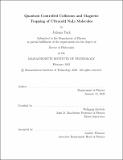| dc.contributor.advisor | Ketterle, Wolfgang | |
| dc.contributor.author | Park, Juliana | |
| dc.date.accessioned | 2023-05-15T19:32:48Z | |
| dc.date.available | 2023-05-15T19:32:48Z | |
| dc.date.issued | 2023-02 | |
| dc.date.submitted | 2023-05-10T19:59:48.530Z | |
| dc.identifier.uri | https://hdl.handle.net/1721.1/150692 | |
| dc.description.abstract | ²³Na⁶Li is a fermionic molecule that has weak singlet-triplet mixing, making it a suitable system to study the triplet rovibrational ground state (𝑎³Σ⁺, 𝑣 = 0,𝑁 = 0). It is notable for its both non-zero electric (0.175 Debye) and magnetic (2𝜇𝐵) dipole moments and small two-body scattering rate, as predicted by the universal model for cold collision. Additionally, ²³Na⁶Li is the lightest bi-alkali molecule, and the theoretical simulation of collisions is relatively feasible compared to other heavy molecules which makes it a promising benchmark system for theoretical quantum scattering calculations.
This thesis describes three experiments and a numerical/theoretical work on ²³Na⁶Li molecules in the triplet ground state. The first two experiments are on molecular Feshbach resonances: in spin-polarized ²³Na⁶Li+²³Na collisions and in ²³Na⁶Li+²³Na⁶Li collisions. The first experiment focuses on the spectroscopic study of Feshbach resonances in two possible spin-polarized ²³Na⁶Li+²³Na collisions from near 0 to 1400 Gauss. This allows learning about the molecular interaction potential surface and intermediate collision complexes, benchmarking theory, and controlling reactive collisions. The second experiment is a report of an unpredicted 𝑝-wave Feshbach resonance in ²³Na⁶Li+²³Na⁶Li collisions and interpretations. The resonance occurs for molecules in the lower stretched hyperfine state near an open-channel degeneracy. The collision loss rate is enhanced by more than two orders of magnitude from the 𝑝-wave universal value at the background to near the 2D unitarity limit.
In addition to the search for magnetically tunable resonances, ²³Na⁶Li molecules in the triplet potential are suitable for magnetic trapping. The third experiment describes building an improved experimental setup that allows magnetic trapping of ²³Na⁶Li molecules and studying various collisions in the magnetic trap by quantum state control of molecules and atoms. The molecular density is a factor of 10⁵ higher than that reported for magnetically trapped ultracold molecules, and the temperature is ≈ 1𝜇𝐾. This condition enables observation of both atom-molecule and molecule-molecule collisions in the ultracold regime and sympathetic cooling of ²³Na⁶Li by evaporative cooling of ²³Na in the magnetic trap.
Lastly, this thesis presents the numerical and theoretical approach to finding a window for an all-optical creation of molecules using Raman transitions from ²³Na and ⁶Li atoms to ²³Na⁶Li molecules. All-optical creation of molecules in which the magnetic association step near a Feshbach resonance is eliminated is expected to broaden the horizon of ultracold molecules to a larger pool and to eliminate the need for high magnetic fields. | |
| dc.publisher | Massachusetts Institute of Technology | |
| dc.rights | In Copyright - Educational Use Permitted | |
| dc.rights | Copyright MIT | |
| dc.rights.uri | http://rightsstatements.org/page/InC-EDU/1.0/ | |
| dc.title | Quantum Controlled Collisions and Magnetic Trapping of Ultracold NaLi Molecules | |
| dc.type | Thesis | |
| dc.description.degree | Ph.D. | |
| dc.contributor.department | Massachusetts Institute of Technology. Department of Physics | |
| mit.thesis.degree | Doctoral | |
| thesis.degree.name | Doctor of Philosophy | |
